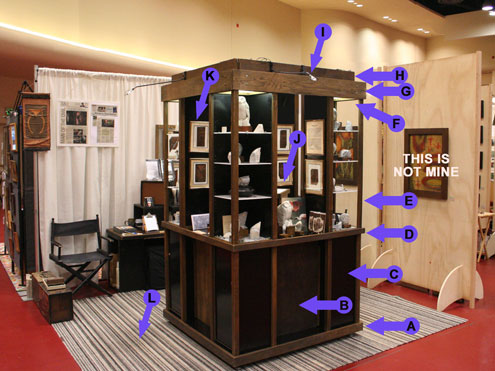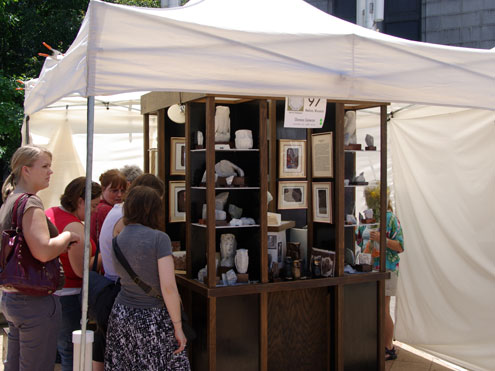|
|
Display at indoor fair |
Display at outdoor fair |
History of this Display
Even though my longtime partner, Bob, is a graduate architect and designed homes for 33 years, the basic idea for this display was mine. It came about in 1992, when I exhibited at the Winter Park (FL) Sidewalk Art Fair. As I was told by one of the volunteers, “This is the first time in 33 years that we have had rain ALL THREE DAYS of the fair.”
We had close to 8” of rain in the three days. My booth area was flooded, and we used the bricks from my display as stepping stones through the water. I thought, if I ever have another booth, it would be raised off the ground so it is not affected by rain. I came up with the basic concept, using threaded lifts at the corners, and the idea that it would be a walk-around booth. Bob just shook his head and said, “People aren’t going to come in and walk around a booth!” I told him, if they were only casually interested, they could see some of my work while walking by. If they really liked my work, they would want to see all of it, and would walk around.
When we returned to Madison, I sketched out the booth and gave the sketch to a wood worker. He quoted me a figure, and I told him to get started. The next day, he called to say he was figuring out the amount of wood he needed to buy and he asked how high I wanted the Mid-Table. I told him I would ask Bob and call him back. When I did ask, Bob was furious that I hadn’t drawn the display to scale and, disgustedly, then decided he should draw it to scale for me. After doing so, he added the oak trim. That really “set off” the entire display. I called the woodworker to find out how much extra the oak would add to the cost. He quoted $300. Wow! It was only trim!
I called John, another woodworker friend, and he came over to look at the plans. His quote for the basic display was about the same, but he was sure the oak would only add $125 to the cost. I hired him and told the other woodworker not to proceed. When John had it built, he brought it over to the house so we could assemble it and drill bolt holes where needed. I pencil-marked each piece, then later burned letters into the wood so they would always go in the same place and always fit….such things as RF (Right Front), LF, RR, and LR. It becomes quite easy to read these initials and immediately know where each piece goes.
The booth does take a little time to assemble, but, once it is together, as John put it, “It will probably stand through a tornado.” I told him not to say such things! Of course, his words were a jinx, and at our first outdoor fair we did have tornado warnings and very high winds, plus rain. Inside, we literally hung onto the closed canopy, but the display did not budge, thus providing protection for my work. Many artists lost their work and/or their booth at that fair.
Indoor fairs are easiest, of course, but if there is security at an outdoor fair, I closed the canopy while “tearing down.” That meant, I moved some owls from the spaces between the columns and stacked any extra boxes of stock in those spaces. Then we wrapped a large tarp around the entire unit, wrapped rope around that, and tied it up. I put one of those personal alarms on the main zipper, so if someone was dumb enough to open the front of the canopy, the alarm would go off. (I always told security about the alarm so, if they heard it, they would know where to look.) In almost twenty-five years of outdoor fairs, I never had a single problem. The next morning, to take those extra boxes off the display and do a bit of rearranging, took very little time.
With two of us in the booth, there were hardly any blind spots. I hung a couple of convex mirrors, 6” to 8” near the top, and they actually covered those spots, further convincing people not to try to shoplift.
The addition of a sales table, and our seating, made the booth become functional. In our case, we used a 2’ x 6’8” hollow-core flush door in back of the above display, set at a convenient height on open wooden boxes, which held personal business items and wrapping supplies. Smaller boxes on top of the door housed the cash box at one end and brochures and business cards at Bob’s end for his wrapping duties. We used a three-panel folding screen between the small boxes to display my 2-dimensional copper work. (Bob adds here that those boxes were part of our telescoping box display that has been used, used, and re-used since 1966. As mentioned earlier, at indoor fairs we used the striped, color coordinated 10’ x 10’+ carpet to set the booth apart on any floor material. This entire display fits into a 10’ x 10’ canopy booth with two chair spaces included.
NOTE: This booth would also be ideal in a small, art boutique or gallery.
|


